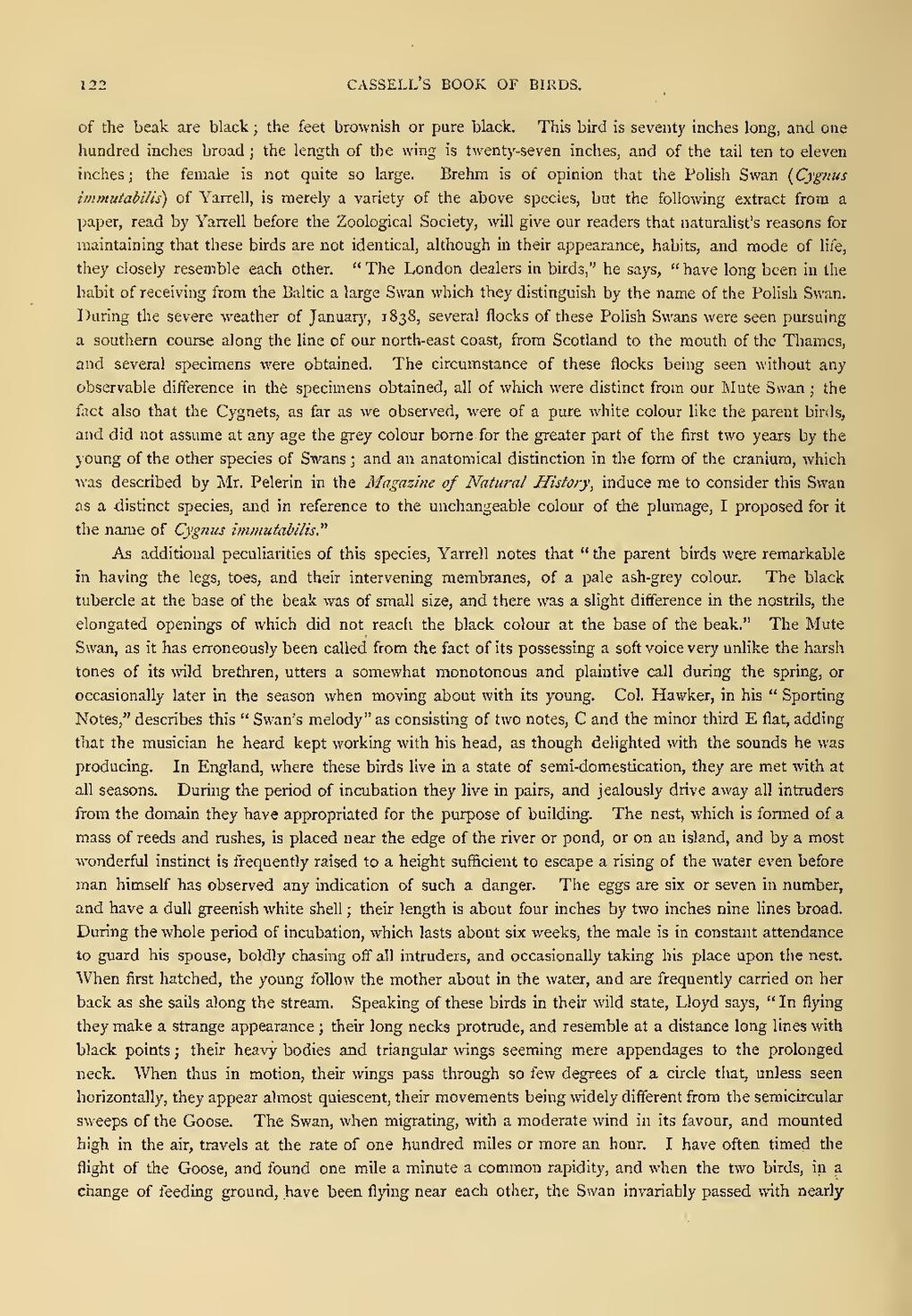of the beak are black; the feet brownish or pure black. This bird is seventy inches long, and one hundred inches broad; the length of the wing is twenty-seven inches, and of the tail ten to eleven inches; the female is not quite so large. Brehm is of opinion that the Polish Swan (Cygnus immutabilis) of Yarrell, is merely a variety of the above species, but the following extract from a paper, read by Yarrell before the Zoological Society, will give our readers that naturalist's reasons for maintaining that these birds are not identical, although in their appearance, habits, and mode of life, they closely resemble each other. "The London dealers in birds," he says, "have long been in the habit of receiving from the Baltic a large Swan which they distinguish by the name of the Polish Swan. During the severe weather of January, 1838, several flocks of these Polish Swans were seen pursuing a southern course along the line of our north-east coast, from Scotland to the mouth of the Thames, and several specimens were obtained. The circumstance of these flocks being seen without any observable difference in the specimens obtained, all of which were distinct from our Mute Swan; the fact also that the Cygnets, as far as we observed, were of a pure white colour like the parent birds, and did not assume at any age the grey colour borne for the greater part of the first two years by the young of the other species of Swans; and an anatomical distinction in the form of the cranium, which was described by Mr. Pelerin in the Magazine of Natural History, induce me to consider this Swan as a distinct species, and in reference to the unchangeable colour of the plumage, I proposed for it the name of Cygnus immutabilis."
As additional peculiarities of this species, Yarrell notes that "the parent birds were remarkable in having the legs, toes, and their intervening membranes, of a pale ash-grey colour. The black tubercle at the base of the beak was of small size, and there was a slight difference in the nostrils, the elongated openings of which did not reach the black colour at the base of the beak." The Mute Swan, as it has erroneously been called from the fact of its possessing a soft voice very unlike the harsh tones of its wild brethren, utters a somewhat monotonous and plaintive call during the spring, or occasionally later in the season when moving about with its young. Col. Hawker, in his "Sporting Notes," describes this "Swan's melody" as consisting of two notes, C and the minor third E flat, adding that the musician he heard kept working with his head, as though delighted with the sounds he was producing. In England, where these birds live in a state of semi-domestication, they are met with at all seasons. During the period of incubation they live in pairs, and jealously drive away all intruders from the domain they have appropriated for the purpose of building. The nest, which is formed of a mass of reeds and rushes, is placed near the edge of the river or pond, or on an island, and by a most wonderful instinct is frequently raised to a height sufficient to escape a rising of the water even before man himself has observed any indication of such a danger. The eggs are six or seven in number, and have a dull greenish white shell; their length is about four inches by two inches nine lines broad. During the whole period of incubation, which lasts about six weeks, the male is in constant attendance to guard his spouse, boldly chasing off all intruders, and occasionally taking his place upon the nest. When first hatched, the young follow the mother about in the water, and are frequently carried on her back as she sails along the stream. Speaking of these birds in their wild state, Lloyd says, "In flying they make a strange appearance; their long necks protrude, and resemble at a distance long lines with black points; their heavy bodies and triangular wings seeming mere appendages to the prolonged neck. When thus in motion, their wings pass through so few degrees of a circle that, unless seen horizontally, they appear almost quiescent, their movements being widely different from the semicircular sweeps of the Goose. The Swan, when migrating, with a moderate wind in its favour, and mounted high in the air, travels at the rate of one hundred miles or more an hour. I have often timed the flight of the Goose, and found one mile a minute a common rapidity, and when the two birds, in a change of feeding ground, have been flying near each other, the Swan invariably passed with nearly
